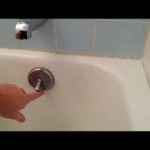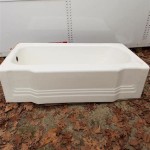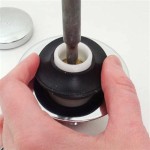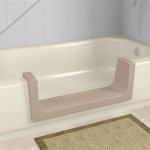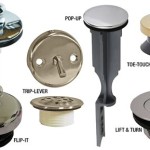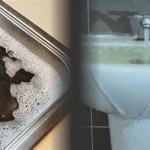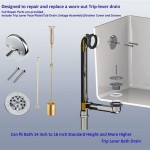Best Material for Bathtub Surround: A Comprehensive Guide
Selecting the appropriate material for a bathtub surround is a crucial decision in bathroom renovation or construction. The surround not only serves an aesthetic purpose, enhancing the overall visual appeal of the bathroom, but also provides essential protection against water damage and mold growth. A well-chosen material will be durable, easy to clean, and resistant to moisture. This article explores several popular materials commonly used for bathtub surrounds, evaluating their pros, cons, and suitability for various applications.
Acrylic Bathtub Surrounds
Acrylic is a synthetic polymer plastic that is frequently used in the manufacturing of bathtub surrounds. It's known for its non-porous surface, which makes it highly resistant to water damage, mold, and mildew. Acrylic surrounds are typically formed by heating a sheet of acrylic and molding it into the desired shape. The resulting surround is then reinforced with fiberglass for added strength and durability.
One of the primary advantages of acrylic surrounds is their ease of installation. They are often available in pre-fabricated panels that can be easily attached to the wall studs. This feature can significantly reduce labor costs associated with the installation process. Furthermore, acrylic is lightweight, which simplifies handling and minimizes the structural support required for installation.
Acrylic is also known for its versatility in terms of design and aesthetics. It can be manufactured in a wide range of colors, patterns, and textures, allowing homeowners to select a surround that perfectly complements their bathroom décor. Some acrylic surrounds even mimic the look of natural stone or tile, offering a cost-effective alternative to more expensive materials. The smooth, non-porous surface of acrylic is also easy to clean and maintain, requiring only mild soap and water to keep it looking its best. Abrasive cleaners should be avoided as they can scratch the surface.
However, acrylic is not without its drawbacks. While it is durable, it is more susceptible to scratches and dents than some other materials, such as tile or stone. It can also become discolored over time, especially in areas exposed to direct sunlight. Additionally, while acrylic panels are relatively easy to install, they may not fit perfectly in all bathroom configurations, requiring some customization or modifications during the installation process. The cost of acrylic surrounds can range from budget-friendly to relatively expensive, depending on the quality, design, and features of the product.
Tile Bathtub Surrounds
Tile is a classic and versatile material that has been used for bathtub surrounds for centuries. It offers a wide range of design possibilities, allowing homeowners to create a truly unique and personalized bathroom space. Tile is available in a variety of materials, including ceramic, porcelain, glass, and natural stone, each with its own unique characteristics and aesthetic appeal.
Ceramic tile is a popular choice for bathtub surrounds due to its durability, affordability, and ease of maintenance. It is resistant to water damage, stains, and scratches, making it well-suited for the humid environment of a bathroom. Porcelain tile is even more durable and water-resistant than ceramic tile, making it an excellent option for high-moisture areas. Both ceramic and porcelain tiles are available in a wide range of colors, sizes, and patterns, offering homeowners ample design flexibility.
Glass tile is another popular option for bathtub surrounds, known for its sleek and modern aesthetic. It is non-porous and stain-resistant, making it easy to clean and maintain. Glass tile can also add a touch of elegance and sophistication to a bathroom, especially when used in combination with other materials. Natural stone tile, such as marble, granite, and travertine, offers a luxurious and timeless look. However, natural stone requires more maintenance than ceramic, porcelain, or glass tile, as it is more porous and susceptible to staining. It is also generally more expensive than other tile options.
One of the main advantages of tile is its durability. Properly installed tile can last for decades with minimal maintenance. It is also highly resistant to water damage, mold, and mildew. However, the grout lines between tiles can be a source of potential problems. Grout is porous and can absorb water, leading to mold and mildew growth if not properly sealed and maintained. Regular cleaning and sealing of grout lines are essential to prevent these issues.
The installation of tile can be more complex and time-consuming than other materials, requiring skilled labor and specialized tools. It is also a more expensive option in terms of labor costs. However, the long-term durability and aesthetic appeal of tile can make it a worthwhile investment. The initial cost can be higher, but the lifespan and aesthetic value provide a long-term payoff. The design possibilities are seemingly endless with different tile sizes, colors, and patterns, and the ability to create intricate mosaics.
Solid Surface Bathtub Surrounds
Solid surface material is a synthetic material composed of a blend of acrylic or polyester resins and mineral fillers. It is non-porous, seamless, and highly durable, making it an excellent choice for bathtub surrounds. Solid surface surrounds are typically available in pre-fabricated sheets that can be cut and shaped to fit the specific dimensions of a bathroom. These sheets are then seamed together using a special adhesive, creating a seamless and watertight surface.
One of the key advantages of solid surface material is its seamless construction. The absence of grout lines eliminates a common source of mold and mildew growth, making it easier to clean and maintain. Solid surface is also highly resistant to stains, scratches, and impacts, making it a durable and long-lasting option. It is available in a wide range of colors and patterns, including options that mimic the look of natural stone or quartz.
Solid surface surrounds are generally more expensive than acrylic surrounds but offer superior durability and aesthetics. They are also easier to repair than tile, as scratches and minor damages can be sanded or buffed out. The non-porous surface of solid surface material prevents water from penetrating, reducing the risk of water damage to the underlying structure.
The installation of solid surface surrounds typically requires professional installation. The sheets need to be precisely cut and seamed together to ensure a watertight fit. While the installation process may be more complex than acrylic surrounds, the resulting seamless and durable surface makes it a worthwhile investment. It provides a sleek, modern look, with a feel that closely resembles natural stone. The consistent color and pattern throughout the material add to its visual appeal, providing depth and richness unmatched by some other surround options.
Fiberglass Bathtub Surrounds
Fiberglass reinforced plastic (FRP) is a common, inexpensive option for bathtub surrounds. These surrounds are typically made by molding fiberglass sheets into the desired shape and then applying a gel coat finish for a smooth, waterproof surface. The term “fiberglass” is often used interchangeably with FRP in this context, and the functionality is very similar.
The primary benefit of fiberglass surrounds is their low cost. They are one of the most affordable options for bathtub surrounds, making them a popular choice for budget-conscious homeowners or in rental properties. Installation is relatively simple, with pre-fabricated units designed for quick and easy setup. This reduces labor costs and installation time.
However, fiberglass surrounds have several limitations. They are less durable compared to acrylic or solid surface materials. The gel coat finish can be prone to scratching and fading over time. The material can also be brittle and susceptible to cracking, especially in areas subject to frequent impact or stress. Cleaning requires care as abrasive cleaners can damage the gel coat. Harsh chemicals can also dull the finish, leaving the surface looking worn.
Aesthetically, fiberglass surrounds offer fewer design options compared to other materials. The color and pattern choices are limited, and the overall look is often considered less luxurious than tile or solid surface. The lightweight nature of fiberglass, while making installation easier, also contributes to its flimsier feel compared to heavier, more robust materials. While cost-effective, the lifespan and aesthetic appeal of fiberglass surrounds may not meet the needs of homeowners looking for a long-term, high-end solution.

Bathtub Guide And Surrounds Make It Right

Beautiful Stone Material To Surround Your Bathtub

What Is A Tub Surround How To Choose For Your Bathroom Badeloft

Installing Tub Surround Over Tile Smart Remodeling Llc

3 Steps To The Perfect Tub Surround Scott Mcgillivray
10 Ideas For Bathtub Surrounds

Enhance Your Bathroom With New Bathtub Surrounds
10 Ideas For Bathtub Surrounds

Tub Shower Surround Panels Msi Surfaces

What Is A Tub Surround How To Choose For Your Bathroom Badeloft

